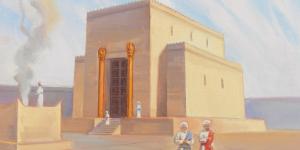You are here
How Does Paul Use Chiasmus to Teach about Jesus’s Atonement?

2 Corinthians 5:19
The Know
Throughout Paul’s ministry, he wrote many epistles to different churches clarifying doctrine, answering concerns, and offering support as needed. Most of his epistles in the New Testament follow fairly standard literary forms of Paul’s time, which has led one New Testament scholar to note that they “are generally among the clearest” of the New Testament writings to outline.1
However, Paul’s second letter to the Corinthians is much more difficult to outline, and many scholars point to its “unparalleled lack of apparent structure and unity,” especially in the beginning of the letter.2 Because of this, many scholars believe that 2 Corinthians is actually a combination of two or more letters that were put together by a later scribe or editor sometime after Paul had written them. However, as evangelical scholar Craig Blomberg has noted, many of these apparent discrepancies in the letter can be resolved when the first seven chapters are read as a large chiasm focused on the Atonement of Jesus Christ.3
Biblical scholars have long recognized the use of chiasmus in the ancient world, especially among ancient Israelites. Paul, having been taught in the Jewish law and having been raised as a Jew, would have likewise been familiar with this literary practice. Indeed, as John W. Welch has observed, Paul used chiasmus to various extents throughout some of his other epistles, such as Galatians and 1 Corinthians.4 As such, it should be no surprise that Paul could use chiasmus in a profoundly complex and meaningful ways.
The chiasm that Blomberg proposes includes six points, followed by verbal and theological parallels in the opposite order that, all together, nicely encapsulate Paul’s overall message of Jesus and His Atonement. This structure is outlined as follows: 5
A: The Corinthians Can Boast in Paul (2 Cor. 1:12-22)
B: Grief and Comfort over a Painful Letter (1:23–2:11)
C: Looking for Titus in Macedonia (2:12–13)
D: Contrasts between Belief and Unbelief (2:13–4:6)
E: Triumphing Despite Hardships (4:7–5:10)
F: Christ’s Ministry of Reconciliation (5:11-21)
E: Triumphing Despite Hardships (6:1–10)
D: Contrasts between Belief and Unbelief (6:11–7:4)
C: Finding Titus in Macedonia (7:5–7)
B: Grief and Comfort over a Painful Letter (7:8–12)
A: Paul Can Boast in the Corinthians (2 Corinthians 7:13–16)
Point A: Boasting in the Lord (2 Corinthians 1:12–22 and 2 Corinthians 7:13–16)
The first and last point of this chiasm express Paul’s assurance to the Corinthian saints that they can boast in the Lord based on Paul’s works and he, in turn, can boast in the Lord for the Corinthian saints’ faith. Paul states that “we [Paul and his companions] are your rejoicing, even as ye also are ours in the day of the Lord Jesus” (2 Corinthians 1:14) and that “I rejoice therefore that I have confidence in you in all things” (2 Corinthians 7:16). This mutual rejoicing was centered on God, who had brought Paul and the Corinthians closer together in the faith.
Point B: Forgiveness and Repentance (2 Corinthians 1:23–2:11 and 2 Corinthians 7:8–12)
Second, Paul refers the Saints to an earlier letter he had written that had apparently caused both the saints and Paul much sorrow. This letter chastised a prominent member of the Corinthian community, and Paul encourages the Corinthians to “forgive him, and comfort him, lest perhaps such a one should be swallowed up with overmuch sorrow. Wherefore I beseech you that ye would confirm your love toward him” (2 Corinthians 2:7–8). Similarly, although Paul had been sorrowful that he needed to chastise the Corinthian community, “now I rejoice, not that ye were made sorry, but that ye sorrowed to repentance: for ye were made sorry after a godly manner, that ye might receive damage by us in nothing. For godly sorrow worketh repentance to salvation” (2 Corinthians 7:9–10). Forgiveness and repentance, Paul teaches, are essential aspects of the Gospel of Jesus Christ.
Point C: Finding Titus in Macedonia (2 Corinthians 2:12–13 and 2 Corinthians 7:5–7)
Third, Paul briefly mentions how he came to Troas to find Titus, but had no success, leading Paul to Macedonia (see 2 Corinthians 2:12–13). Once Paul had arrived, he met Titus who “told us your earnest desire, your mourning, your fervent mind toward me; so that I rejoiced the more” (2 Corinthians 7:7). Although this story is broken up into two parts, it gives greater context into the hope Paul initially felt and the rejoicing he felt in the Corinthians at the end of the chiasm.
Point D: Belief and Unbelief (2 Corinthians 2:14–4:6 and 2 Corinthians 6:11–7:4)
Fourth, Paul offers a series of contrasts between belief and unbelief. These contrasts are ultimately for the saints to be “transformed into [God’s] image” and “holiness.”6 Paul declares God “hath made us able ministers of the new testament; not of the letter, but of the spirit,” (2 Corinthians 3:6) and “hath shined in our hearts, to give the light of the knowledge of the glory of God in the face of Jesus Christ” (2 Corinthians 4:6). This light transforms the saints and helps them combat “the god of this world” who seeks to blind others to the light of Christ (2 Corinthians 4:4). And, ultimately, just as God shined His light in the saints, Paul declares that the saints have become “the temple of the living God; as God hath said, I will dwell in them, and walk in them; and I will be their God, and they shall be my people” (2 Corinthians 6:16). Because of this, the saints are told to “cleanse [them]selves from all filthiness of the flesh and spirit, perfecting holiness in the fear of God” (2 Corinthians 7:1).7
Point E: Triumphing Over Hardships (2 Corinthians 4:7–5:10 and 2 Corinthians 6:1–10)
Fifth, Paul declares that although the saints may face hardships throughout their lives, they can rest assured knowing that they will be “persecuted, but not forsaken; cast down, but not destroyed … For our light affliction, which is but for a moment, worketh for us a far more exceeding and eternal weight of glory” (2 Corinthians 4:9, 17). And as the saints relied on God, they could overcome these challenges “by pureness, by knowledge, by longsuffering, by kindness, by the Holy Ghost, by love unfeigned, by the word of truth, by the power of God, by the armour of righteousness on the right hand and on the left” (2 Corinthians 6:6–7).
Point F: The Ministry of Reconciliation (2 Corinthians 5:11–21)
Finally, the climax and turning point of this chiasmus appears in 2 Corinthians 5:11–21. As the central theme of Paul’s message to the Corinthians, he focuses on the Atonement of Jesus Christ. Specifically, Paul teaches that “all things are of God, who hath reconciled us to himself by Jesus Christ, and hath given to us the ministry of reconciliation; to wit, that God was in Christ, reconciling the world unto himself, not imputing their trespasses unto them; and hath committed unto us the word of reconciliation” (2 Corinthians 5:18–19).8
As Blomberg has noted, “no more appropriate center” for this chiasm could be found.9 Indeed, the most significant part of any chiasm is the central theme, and Paul makes it clear that nothing He has said before or after this could be possible without Jesus’s atoning sacrifice allowing the saints to become “new creatures” (see 2 Corinthians 5:17). Christ’s Atonement was ultimately central to Paul’s concerns, as it alone allowed the saints to boast in the goodness of God, repent, act in belief, and be transformed through Christ’s love.
The Why
The chiasm found in 2 Corinthians 1–7 is much like other large chiasms found in the scriptures that focus on Jesus Christ’s Atonement. The central message of the gospel is, of course, that Jesus Christ atoned for our sins and allows us to become new creatures through His grace and mercy. The chiastic form focuses, perhaps better than any other literary device, upon an important, central turning point. Paul, being well trained in the language and literature of his day, was no stranger to the chiastic style of composition and its emphatic highpoint.
Some of his audience would probably have been aware of this style of composition and could have consciously appreciated the emphasis it placed on the central turning point. At the same time, those who had not been so trained could naturally have sensed the logic of building up to the climatic high point and then retracing the steps back to the starting point.
Similar to Paul’s focus on the Atonement in these chapters, Alma’s report of his personal conversion is told in a lengthy and complex chiasm that focuses entirely on his being forgiven of sins and redeemed through the Atonement of Jesus Christ.10 Through comparisons of his life before and after his conversion, the effects of the Atonement are made clear in no uncertain terms. Similarly, through Paul’s lengthy discourse on righteous and unrighteous living, overcoming trials through Christ, and proper boasting in His love, Paul makes clear that the Atonement of Jesus Christ is the very turning point upon which all things of God are focused and thus is the keystone upon which all blessings of the gospel are founded.
Further Reading
John W. Welch, “Chiasmus in the New Testament,” in Chiasmus in Antiquity: Structures, Analyses, Exegesis, ed. John W. Welch (Hildesheim: Gerstenberg Verlag, 1981), 211–249.
John W. Welch and Donald W. Parry, eds. Chiasmus: The State of the Art (Provo, UT: BYU Studies, 2020).
Craig Blomberg, “The Structure of 2 Corinthians 1–7,” Criswell Theological Review 4, no. 1 (1989): 3–20.
- 1. Craig Blomberg, “The Structure of 2 Corinthians 1–7,” Criswell Theological Review 4, no. 1 (1989): 3.
- 2. Blomberg, The Structure of 2 Corinthians 1–7,” 3.
- 3. Other scholars have noted that chiasmus could be used in larger texts. For discussions on the use of chiasm in antiquity, including how large texts could be drafted around one, see John W. Welch and Donald W. Parry, eds. Chiasmus: The State of the Art(Springville, UT: Book of Mormon Central; Provo, UT: BYU Studies, 2020). For reference and discussion of Blomberg’s work, see Neal Rappleye, “Chiasmus Criteria in Review,” in Chiasmus: The State of the Art, 292–293.
- 4. John W. Welch, “Chiasmus in the New Testament,” in Chiasmus in Antiquity: Structures, Analyses, Exegesis, ed. John W. Welch (Hildesheim: Gerstenberg Verlag, 1981), 213–219. For additional examples of chiasmus in Paul’s epistles, see pp. 213–229.
- 5. An overview of this chiasm can be found in Blomberg, “The Structure of 2 Corinthians 1–7,” 8–9.
- 6. Blomberg, “The Structure of 2 Corinthians 1–7,” 9.
- 7. It is worth noting that each of these points are further divided into a further chiasm, as discussed in Blomberg, “The Structure of 2 Corinthians 1–7,” 12–14.
- 8. It is worth noting that the word translated as “reconciliation” in the King James Version is katallagē, which is the same word translated in Romans 5:11 as “atonement.”
- 9. Blomberg, The Structure of 2 Corinthians 1–7,” 14.
- 10. See Book of Mormon Central, “Why Was Alma Converted? (Alma 36:21),” KnoWhy 144 (July 15, 2016).
KnoWhy Citation
Related KnoWhys
Subscribe
Get the latest updates on Book of Mormon topics and research for free





